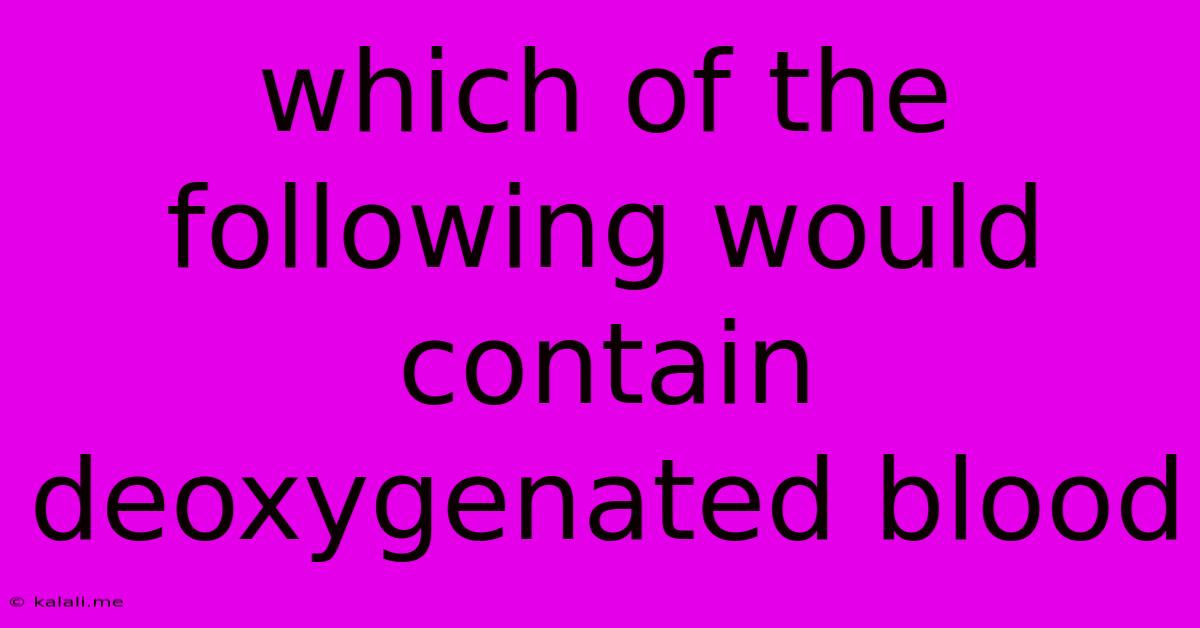Which Of The Following Would Contain Deoxygenated Blood
Kalali
Jun 12, 2025 · 2 min read

Table of Contents
Which of the Following Would Contain Deoxygenated Blood? Understanding Blood Circulation
This article will explore the circulatory system and identify which structures typically carry deoxygenated blood. Understanding the flow of oxygenated and deoxygenated blood is crucial for comprehending human physiology. We will delve into the key vessels and chambers involved in this vital process.
Deoxygenated blood, as the name suggests, is blood that has a lower concentration of oxygen and a higher concentration of carbon dioxide. This blood needs to be transported to the lungs for oxygenation before being circulated to the rest of the body. This process is a fundamental part of respiration and overall bodily function.
The Pulmonary Circuit: The Journey of Deoxygenated Blood
The journey of deoxygenated blood begins in the body's tissues. After releasing oxygen and picking up carbon dioxide, this blood is collected by veins and travels towards the heart. Specifically, it enters the right side of the heart.
- Superior and Inferior Vena Cava: These large veins return deoxygenated blood from the upper and lower body, respectively, to the right atrium of the heart.
- Right Atrium: This chamber receives deoxygenated blood from the vena cava.
- Right Ventricle: The right atrium pumps the blood into the right ventricle, the next chamber in line.
- Pulmonary Artery: This is a crucial point. Unlike most arteries carrying oxygenated blood, the pulmonary artery carries deoxygenated blood from the right ventricle to the lungs. This is the only artery in the body carrying deoxygenated blood.
- Pulmonary Capillaries (in the lungs): Within the lungs, the blood travels through a network of capillaries where carbon dioxide is released and oxygen is picked up.
Oxygenated Blood's Return and Systemic Circulation
Once oxygenated in the lungs, the blood travels back to the heart via the pulmonary veins. This is the only vein in the body carrying oxygenated blood. This oxygen-rich blood then enters the left side of the heart and is pumped to the rest of the body.
Structures Containing Primarily Deoxygenated Blood:
Based on the explanation above, the structures that primarily contain deoxygenated blood are:
- Superior and Inferior Vena Cava
- Right Atrium
- Right Ventricle
- Pulmonary Artery
It is important to note that there might be a small amount of mixing of oxygenated and deoxygenated blood in the heart, particularly in the areas where the chambers connect. However, the structures listed above predominantly carry deoxygenated blood.
Understanding Blood Flow is Key
Understanding the difference between oxygenated and deoxygenated blood flow, and the specific vessels and chambers involved, is crucial for grasping the complexities of the circulatory system. This knowledge is essential for understanding various physiological processes and diagnosing cardiovascular conditions. Further study of the circulatory system will reveal a greater appreciation for the intricacies of this vital bodily function. This includes understanding the roles of different blood cells like red blood cells (erythrocytes) and their relationship to oxygen transport.
Latest Posts
Latest Posts
-
Formula For Distance Between Two Lines
Jun 13, 2025
-
What Is A Major Element Found In Chlorophyll
Jun 13, 2025
-
Biggest Railway System In The World
Jun 13, 2025
-
Which Of The Following Is An Example Of A Compound
Jun 13, 2025
-
Features Of A Rational Graph Calculator
Jun 13, 2025
Related Post
Thank you for visiting our website which covers about Which Of The Following Would Contain Deoxygenated Blood . We hope the information provided has been useful to you. Feel free to contact us if you have any questions or need further assistance. See you next time and don't miss to bookmark.